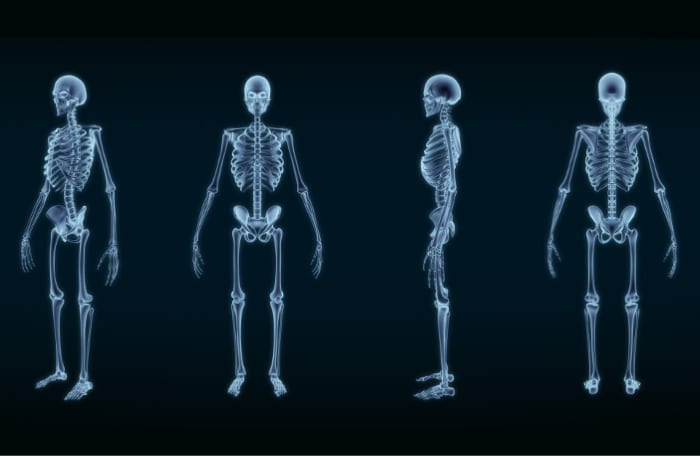Deep learning sheds new light on musculoskeletal diseases and genomic evidence related to the evolution of the human skeletal form
Researchers have used artificial intelligence and X-ray images to study the genetic basis, evolution, and health consequences of human skeletal traits, according to a new study in Science.
The new approach developed by researchers at the New York Genome Center (NYGC) and the University of Texas at Austin (UT at Austin) combined artificial intelligence, dual-energy x-ray images, and genetic data from over 30,000 individuals in the UK Biobank to perform the largest and most comprehensive genomic study of human skeletal proportions to date.
The distinctive human form of shorter arms relative to legs, a narrow body and pelvis, and the orientation of the vertebral column set us apart from other primates. Mechanisms and processes underlying limb development, structure, and skeletal layout have been studied extensively over hundreds of years, but evidence of the genomic change has been elusive.
“A major goal of the study is to address the lack of data on the genes responsible for the differences and specific growth of individual bones in the human skeletal form,” said Tarjinder (TJ) Singh, PhD, Associate Member at NYGC, Assistant Professor in the Columbia University Department of Psychiatry, the Mortimer B. Zuckerman Mind Brain Behavior Institute at Columbia University, the New York State Psychiatric Institute, and the study’s co-senior author.
Genotype-to-phenotype mapping of overall skeletal form
Applying deep learning methods to non-invasive medical imaging is a powerful way to extract skeletal measures in an accurate and scalable manner. These methods were used to gather comprehensive human skeletal measurements from over 40,000 full-body X-ray images from the UK Biobank, thus extracting 23 different skeletal proportions.
Over the past two decades, genome-wide association studies (GWAS) have become an important tool for studying the human genome. Using GWAS, scientists have identified thousands of genetic mutations or variants associated with many diseases and traits such as height. These studies are conducted by comparing the genomes of large populations to find variants that occur more often in those with a specific disease or trait.
Following the application of deep learning, researchers performed GWAS on the 23 skeletal proportions and identified over a hundred genetic variants associated with these proportions. These points are enriched with genes tasked with the job of regulating skeletal development and occur near genes associated with rare human skeletal diseases.
The role of biomechanics in musculoskeletal disease risk
In their study in Science, the teams leveraged the large UK Biobank sample size and recent advances in deep learning to identify novel trait and genetic associations between a human’s skeletal proportions and certain diseases.
Musculoskeletal disorder osteoarthritis (OA) is the leading cause of adult disability in the United States, yet there is little data on how the skeletal frame may exacerbate an individual’s development of the disease. OA is thought to be influenced by a variety of risk factors that range across obesity, mechanical stresses, genetic factors, and the geometric structure of certain bones.
Paying particular attention to the hip and knee joints, the studies indicate that OA of the hip and the knee typically do not occur together or in combination with OA in other large joints, suggesting that local factors are significant in OA development.
“The association between specific skeletal proportions, but not overall height, and joint-specific OA highlight the biomechanical role that these proportions play in shaping stresses on the joints themselves and highlight specific risk factors of clinical relevance,” said Vagheesh Narasimhan, PhD, Assistant Professor in the Departments of Integrative Biology, Statistics and Data Science, Population Health at UT at Austin, and the study’s co-senior author.
Natural selection and its impact on traits
Since human skeletal proportions are an important part of a human’s ability to use two feet when walking, running, or jumping, the team investigated whether variants associated with the human skeletal form have undergone an accelerated evolution.
“Our study shows that in contrast to cardiovascular, immunity, and metabolic traits, the locations associated with these skeletal proportions are significantly enhanced in the conserved genomic regions with human-specific sequence changes and in regulatory elements of genes differentially expressed through development between humans and great apes.”, said Eucharist Kun, a PhD student at UT Austin and the first author of the study.
This provides genomic evidence of selection shaping fundamental anatomical changes that have been observed in the fossil record of human evolution.
The study shows the power of combining large-scale biobank data, machine learning, and genomics to help us understand human health and disease. Singh, who joined the New York Genome Center in 2022, is now applying these techniques to understand the causes of psychiatric disorders.
Additional study authors include Faris Gulamali of The Mount Sinai Hospital / Mount Sinai School of Medicine; Emily M. Javan, Olivia Smith, Javier de la Fuente, Brianna I. Flynn, Kushal Vajrala, Zoe Trutner, Prakash Jayakumar, and Elliot M. Tucker-Drob of University of UT at Austin; and Mashaal Sohail, Universidad Nacional Autónoma de México (UNAM). The research was funded by the Allen Institute, Good Systems at UT Austin and the National Institutes of Health, with graduate student fellowship support provided by the National Science Foundation and UT Austin’s provost’s office.
About the New York Genome Center
The New York Genome Center (NYGC) is an independent, nonprofit academic research institution that serves as a multi-institutional hub for collaborative genomic research. Leveraging our strengths in technology development, computational biology, and whole genome sequencing, our mission is to advance genomic science and its application to novel biomedical discoveries. NYGC’s areas of focus include the development of computational and experimental genomic methods and disease-focused research to advance the understanding of the genetic basis of cancer, neurodegenerative disease, and neuropsychiatric disease. We are committed to prioritizing diversity, equity, and inclusion, which is fundamental to promoting greater collaboration, innovation, and discovery. nygenome.org
